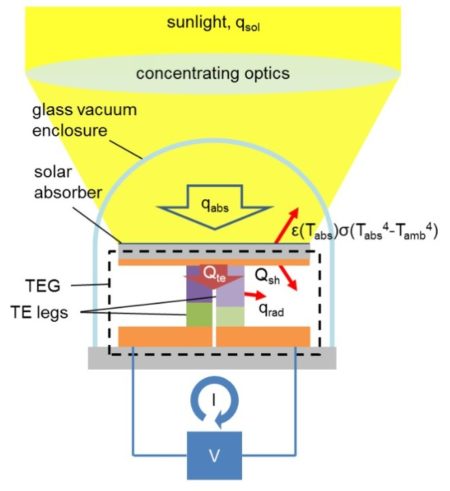Oct
6
Doubling Solar Absorbers More Than Doubles Energy Gain
October 6, 2016 | Leave a Comment
The research group demonstrated an efficiency of 7.4 percent but reported that based upon their calculations, the device could achieve an efficiency of 9.6 percent. Their previous work resulted in an efficiency of 4.6 percent. That’s better than double.
Their findings have been published in Nature Energy.

CSTEG schematic illustrating heat flows. Image Credit: Zhifeng Ren, University of Houston. Click image for the largest view.
By combining concentrating solar power – which converts light into heat that is then used to generate electricity – with segmented thermoelectric legs, made up of two different thermoelectric materials, each working at different temperature ranges, the researchers said they have demonstrated a promising new alternative solar energy technology.
Zhifeng Ren, MD Anderson Professor of physics at the University of Houston and an author of the paper, said the work illustrates a new low-cost, nontoxic way to generate power. While it’s not intended to replace large-scale power plants, it could prove especially useful for isolated areas that aren’t on a traditional electric grid, powering small clusters of homes or businesses, for example, he said. In addition to generating electricity, the technology also can produce hot water – valuable for both private and industrial purposes.
The other authors on the paper include Gang Chen, Daniel Kraemer, Kenneth McEnaney, Lee A. Weinstein and James Loomis, all of MIT, and UH researchers Qing Jie, Feng Cao and Weishu Liu.
Ren, who also is a principal investigator at the Texas Center for Superconductivity at UH, said the work draws on the researchers’ earlier work, which demonstrated proof of the concept. For this project, supported in part by the Department of Energy, they actually built a device to measure how well optical concentration worked to improve the overall system efficiency.
In the research paper the group said, “The performance improvement is achieved by the use of segmented thermoelectric legs, a high-temperature spectrally selective solar absorber enabling stable vacuum operation with absorber temperatures up to 600º C, and combining optical and thermal concentration. Our work suggests that concentrating STEGs (solar thermoelectric generators) have the potential to become a promising alternative energy technology.”
To gain the higher efficiency, the researchers used a solar absorber, boosted by optical concentrators to increase the heat and improve the energy density. The absorber was placed on legs constructed of thermoelectric materials. While their previous work used only bismuth telluride – a well-known thermoelectric material – this version used skudderudite for the top half of the legs and bismuth telluride for the lower half.
Thermoelectric materials produce electricity by exploiting the flow of heat current from a warmer area to a cooler area. By using two materials, the researchers said they were able to take advantage of a broader range of temperatures produced by the solar absorber and boost generating efficiency.
Skutterudite, for example, performs best at temperatures above 200º C, while bismuth telluride works optimally at temperatures below that level.
The group also reported in the paper, “The record-high efficiencies are achieved by segmenting two thermoelectric materials, skutterudite and bismuth telluride, coupled to a spectrally selective surface operated at close to 600º C by combined optical and thermal concentration of the sunlight.”
Solar thermoelectric generators haven’t shaken up much of any market. So far the best of them have managed 5.2 percent. But we’re talking heat here, not photovoltaic – so the effect on energy capture isn’t the same. This is raw heat.
Still, closing in on 10 percent isn’t a huge number or a breakthrough, but it does mark a great step forward. If the circumstances have fuel sources quite expensive or the grid far enough away to be economically nonsensical, and you need heat, this technology has great appeal. Is it viable for heating homes and providing hot water? Not yet, but the technology is now a much, much closer.

